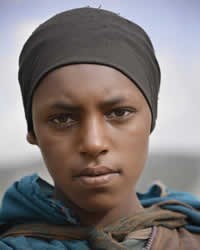Oromo, Anfillo in Ethiopia

Photo Source:
Rod Waddington - Flickr
Creative Commons
|
Send Joshua Project a map of this people group.
|
| People Name: | Oromo, Anfillo |
| Country: | Ethiopia |
| 10/40 Window: | Yes |
| Population: | 700 |
| World Population: | 700 |
| Primary Language: | Oromo, West Central |
| Primary Religion: | Islam |
| Christian Adherents: | 20.00 % |
| Evangelicals: | 4.50 % |
| Scripture: | Complete Bible |
| Ministry Resources: | Yes |
| Jesus Film: | Yes |
| Audio Recordings: | Yes |
| People Cluster: | Omotic |
| Affinity Bloc: | Horn of Africa Peoples |
| Progress Level: |
|
Introduction / History
The Anfillo are from the Omotic language group and have linguistic similarity with Shakacho. The Anfillo people were originally speakers of the Nilo-Saharan language but, abandoning it, shifted to the Omotic language of their conquerors, the Busasi from Kefa when they fell under their domination in the seventeenth century AD. Because of the severe repression and slavery which they experienced under the Busasi, the Anfillo people fled from their original land to Anfillo which is located at the heartland of Wellega.
Coming into contact with the Oromo people of Wellega, once again they abandoned their Omotic language to become speakers of the Oromo language. Today the Southern Mao of the Anfillo people found around Anfillo in Oromiya Regional State are all native speakers of Oromiffa.
What Are Their Lives Like?
The Anfillo Oromo are agriculturalists growing maize, durra, tef, barley, beans, coffee and enset. They make much use of honey and press beeswax into cakes which they sell. Cattle are scarce, but instead, they raise goats and sheep. They are good hunters who could organize hunting lasting for a week. Their diet consists of milk and butter from sheep and goats.
Anfillo Oromos cannot marry someone from the same clan. Marriage is concluded by means of an exchange of brides between two clans, the bride, usually given to the other clan being the suitor's sister.
What Are Their Beliefs?
The Anfillo Oromos believe in a supreme being whom they call Yere, who has two assistants. The first, Sanci Gai, is the creator of the Anfillo Oromo to whom prayer is made in the event of an epidemic. The second, Karifo, is the lord of the rain, and prayers are made to him for the success of the harvest.
What Are Their Needs?
Anfillo Oromos need to put all their hope and faith in the One True God, and his son, Jesus Christ.
Prayer Points
Pray for the Holy Spirit to move among Anfillo Oromo family leaders, opening doors to the gospel.
Pray for the Lord to show himself all powerful and loving by giving them an abundant harvest this year.
Pray that soon Anfillo Oromo disciples will make more disciples.